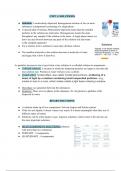Class notes
Chemistry of Solutions: Full Notes Package
- Course
- 202 NYB 05
- Institution
- Vanier College ( )
These notes delve into the different units of "Chemistry of Solutions". Each document explores the specific unit in depth, providing true definitions for terms, worked out examples, and formulas. The notes are organized carefully and images are provided throughout the notes to provide visual depict...
[Show more]



